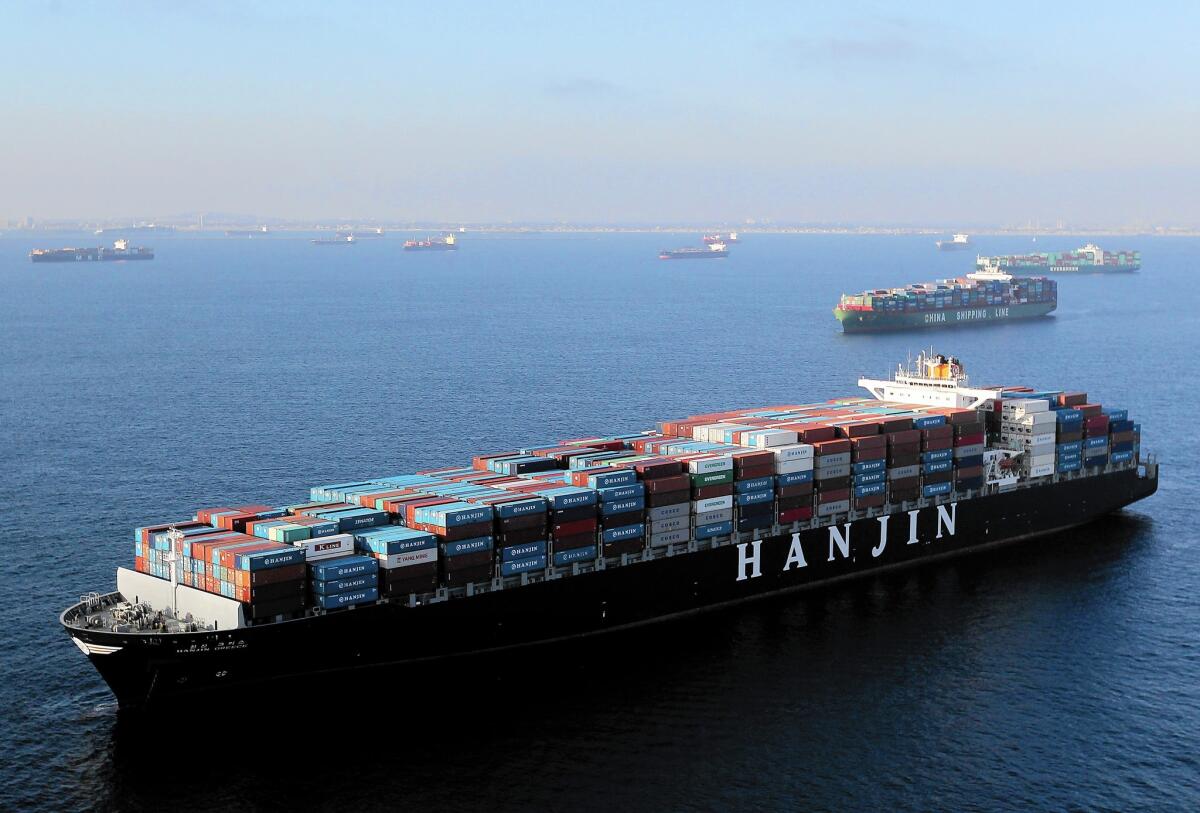L.A., Long Beach ports losing to rivals amid struggle with giant ships

Huge cargo ships anchor offshore at the ports of Los Angeles and Long Beach.
- Share via
C.J. Nord spends her days tracking shipments of metal parts from China, Taiwan and Italy, which her Huntington Beach company assembles into high-end bathroom fixtures for customers demanding quick delivery.
The congestion at Southern California ports, sometimes delaying her shipments for weeks, has sparked a radical new strategy. She now pays a premium to send some parts though East Coast ports and truck them across the nation — rather than directly from ports 20 miles away.
“In an Amazon-driven day and age, the consumers’ expectation for when they should get something has gotten shorter and shorter,” said Nord, the supply chain manager for California Faucets.
The wait at the Los Angeles and Long Beach ports has gotten longer and longer, eroding their share of international trade.
The ports are scrambling to respond to rapid changes in global shipping, most notably the advent of giant cargo ships now clogging the docks with massive loads. Labor strife — including the recent longshoremen’s contract impasse and the lasting effects of a 2002 lockout — has also played a role in the ports’ shrinking market share.
The ports handled 39% of U.S. container imports in 2002; that fell to 32% by 2013, according to U.S. census data. They have lost business to competitors at a time when, overall, global trade is booming and imports are rising at all ports, including L.A. and Long Beach.
“The dominance of Southern California as the Asia gateway is facing a lot more competition,” said maritime consultant John Martin, who analyzed the trade data.
The loss in market share represented an estimated 12,300 direct and indirect California jobs in 2013, and more than $112 million in state and local tax revenue, according to Martin’s research.
The sudden growth of ship size has ports across the world scrambling to update infrastructure. Many are moving faster than L.A. and Long Beach, which are in the throes of multibillion-dollar expansions.
Ports along the East Coast and in Houston have invested billions of dollars to deepen harbors, expand terminals and upgrade rail systems that connect to lucrative markets in the Midwest. The port of Savannah, Ga., has more than doubled the volume of imported container goods over the last decade, while the Canadian government and railways expanded British Columbia’s Port of Prince Rupert to become a direct competitor to U.S. ports farther south.
“When you are No. 1 in the nation, everybody’s going to come after you,” said Gene Seroka, executive director of the Port of Los Angeles.
The bottlenecks at crucial commercial gateways have led to increased costs for U.S. retailers and manufacturers, many of which have resorted to stockpiling goods in warehouses or using expensive air freight to ensure timely delivery of goods.
The congestion problems are magnified at the ports of Los Angeles and Long Beach because of the huge volumes they handle. Long before the labor dispute between shipping companies and dockworkers in recent months, the San Pedro Bay ports were among the first in the U.S. to contend with the challenges posed by massive new vessels deployed by shipping lines across the world.
Big boats
After years of financial struggles, amplified by the global recession, ocean freight carriers have slashed costs and squabbled over their shares of the massive and growing international shipping industry.
That’s sparked a race to build megaships that can carry thousands more containers, capable of moving more cargo on less fuel. The average container ship being built now is nearly three times the size of the average a decade ago.
The quest for efficiency at sea has overwhelmed the infrastructure on shore. The entire supply chain has been stretched thin, from dockworkers manning cranes to truck drivers stuck in lines to warehouse workers who sort goods destined for merchants nationwide.
To fill enormous ships, ocean carriers are also making agreements to share vessels and pool cargo to save money. Sixteen shipping companies operating in four major corporate alliances now control about 80% of the world’s container shipping fleet, according to industry analyst Alphaliner.
That consolidation has caused immense headaches at port terminals, where longshoremen must sort through containers from multiple carriers before they can be fetched for truckers waiting to pick them up.
It’s a puzzle that Noel Hacegaba, chief commercial officer at the Port of Long Beach, refers to as the “Rubik’s cube.”
In the past, each shipping line typically arrived at a separate terminal with goods loaded in a particular order, for distribution to Chicago or New York or Kansas City. With the new alliances, containers from many different shipping lines are arriving at the same terminals — with their cargo stacked at random.
“It’s all mixed up. The guys have to dig for things and find things,” said Bobby Olvera Jr., president of the San Pedro chapter of the International Longshore and Warehouse Union. “No matter what we do here, we are trying to catch the cat’s tail.”
The hodgepodge of containers can leave truck drivers like Danny Lima waiting in lines up to four hours long. He and other truckers are dispatched to pick up a specific container for a retail customer — even if it’s buried at the bottom of a pile.
“We need to get it,” Lima said. “Whether it’s an hour or three hours.”
Since dockworkers and shipping companies reached an agreement on a new labor contract in February, the two ports have made progress in reducing a severe backlog. But the true test will come as the ports enter the peak shipping season, said international trade economist Jock O’Connell.
“Congestion will be an ongoing challenge going forward for the ports,” O’Connell said.
Caught short
The cargo chaos is exacerbated by bureaucratic realities of updating port infrastructure — up to a decade of environmental impact studies, funding approval and permitting.
“There’s no way L.A. and Long Beach could have foreseen enough five years ago to get this in place,” said Paul Bingham, an economist at Hackett Associates, a trade and transportation consulting group. “The industry can go to a shipyard, say ‘I want this new ship,’ and build them in 12 months.”
Now the ports are struggling to catch up. Among the biggest expansions: a $1.3-billion plan in Long Beach to replace the Gerald Desmond Bridge, which is too low for ships expected to be calling in the next five years; and a separate $1.3-billion expansion of two Long Beach port terminals that will create one of the most automated docks in the country.
The Port of Los Angeles is in the midst of a similar $510-million project to upgrade and automate one of its major terminals, known as TraPac.
Some of those plans will bring additional capacity for larger ships as early as this year, but they are still years away from final completion.
In the meantime, both ports are acquiring off-site storage yards for sorting containers in an effort to free up space on the docks and prevent crippling delays for truckers.
New threats
Clearing port congestion is key to staving off rivals seeking an ever-bigger piece of transpacific trade, especially in the face of an unpredictable global economy.
“We’re the fastest, most direct route from Asia. But we can’t rely on geography alone,” Hacegaba said. “We have to demonstrate that our operations and our gateways are as efficient as they can be.”
Higher wage rates in China have pushed some global manufacturing operations farther west to places such as Southeast Asia and India — making East Coast ports an equidistant journey by sea.
The ports of New York and New Jersey have embarked on a billion-dollar-plus plan to raise the Bayonne Bridge connecting Staten Island and New Jersey. Ports from Baltimore to Savannah to Miami are spending hundreds of millions of dollars dredging deeper channels for larger vessels.
Some competitors are openly seeking to capitalize on the problems of Southern California ports. Advertisements for shipping to Prince Rupert in British Columbia tout “infrastructure solutions” at the “congestion-free” port.
The much-anticipated widening of the Panama Canal, expected next year, could pose another threat. It will allow for much larger ships to pass through the locks, opening the potential for transpacific cargo to bypass West Coast ports.
But even that project did not anticipate the rapid shift to mammoth vessels: The largest ships now calling at the Port of Long Beach won’t be able to fit through the newly widened Panama Canal.
Southern California ports’ eroding market share owes in part to stricter environmental regulations, experts said. Emissions upgrades for port trucks, for instance, arrived sooner here than in other parts of the country.
The complex array of forces at work don’t help C.J. Nord, at California Faucets, explain to her customers why they have to wait.
She tries to manage her suppliers around the world to limit the delays. Nowadays she sends a disclaimer to factory suppliers in Asia and Europe: Add at least three weeks to the transit times the ocean shipping companies list on their websites.
“The problem is on our side of the ocean, not theirs,” she said.
More to Read
Inside the business of entertainment
The Wide Shot brings you news, analysis and insights on everything from streaming wars to production — and what it all means for the future.
You may occasionally receive promotional content from the Los Angeles Times.












